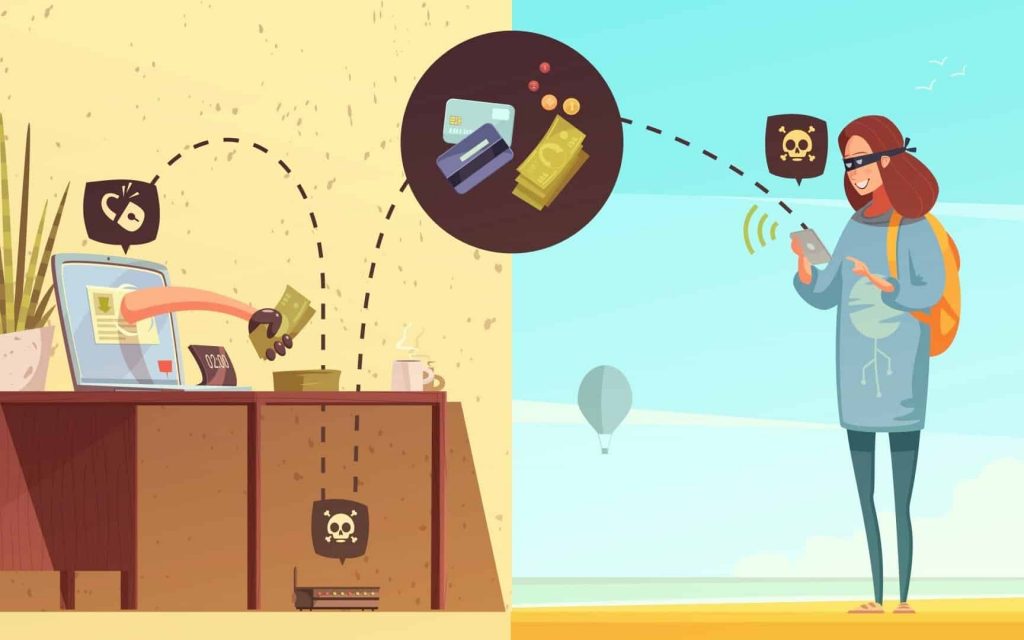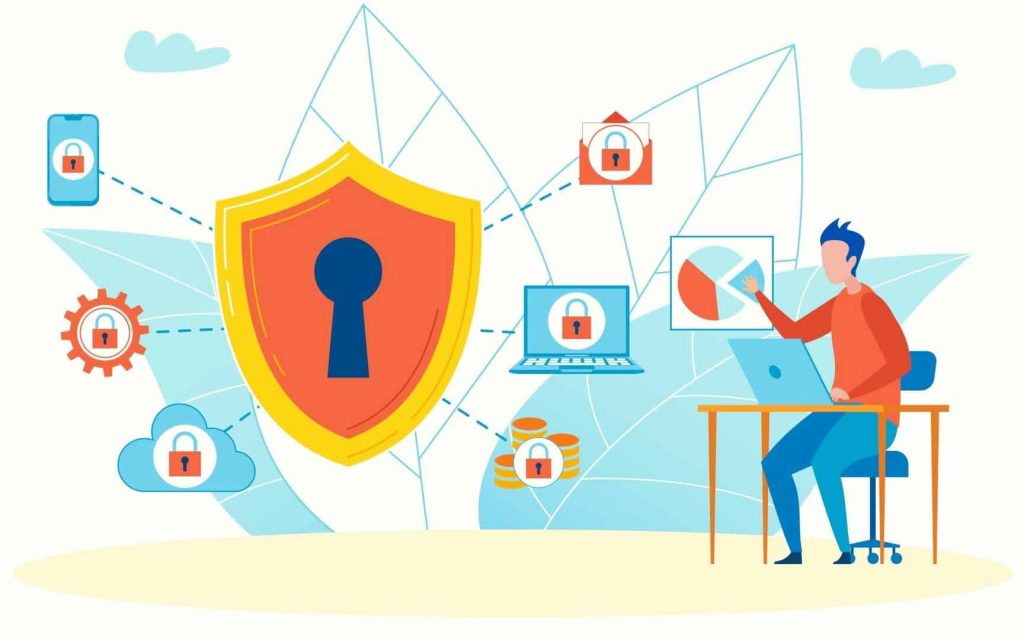Identity theft remains a significant issue, globally, and in Canada. Identity theft happens when your data is breached or stolen from where it is held. The crime can happen in several ways and is usually perpetrated to gain financially. Once criminals have your data they can do many things. They may:
- Open bank accounts in your name
- Take out credit cards
- Rent apartments
- Spend money from your accounts and cards
- Set up social media accounts in your name and damage your reputation
- Post messages on opened social media accounts also damaging your reputation
- Harass you
- Conduct other criminal activities and commit crimes that police believe you are responsible for
- Apply for social security benefits in your name
How does identity theft happen?

In the past identity theft might have been the passing off of checkbooks and cards belonging to another person. As technology has become more sophisticated, identity theft is on the rise. Identity thieves are often expert computer hackers. This type of crime is often now committed without ever stealing anything over than information. In the past criminals might rummage through bins for sensitive information. Unshredded paper bills and documents can be used as stepping stones for identity theft criminals to open new financial accounts in another person’s name. That process seems outdated now.
Identity theft examples
Criminals prefer a far cleaner and from afar method of harvesting a person’s data. That being said, some of the ruses used are still relatively simple:
Phishing Scams
A common example is for criminals to send emails on mass to unsuspecting recipients. This is known as a phishing scam. A professional enough looking email from a large bank asking for data and login information is dismissed by most. But it is still fruitful enough for thieves as it only takes a few to be tricked for them to help themselves to plenty of bank accounts. Phishing scams are often far more inventive. They are designed to create a sense of urgency so that you hand over money or details without thinking carefully. The Canadian anti-fraud centre has a list of scams that you can familiarise yourself with, in the event you are targeted. Hackers don’t need such direct help though.
Hacking through email access and/or inadequate security

By opening suspect emails you can give hackers all they need to make a trawl of the data on your device. You don’t need to have given hackers any sensitive information like in a phishing scam. If you don’t have adequate security then you could allow hackers to access all of your data on your laptop. A perfect haul for a hacker would be to obtain:
- Bank account details, cards, and PINS
- Credit card details and PINS
- Passport
- Driver’s license
- Social security Number
Many people who are not so savvy may overlook personal security on devices we use. But consider how much information you have on your laptop. Most people have been asked for a photo of their passport, driver’s license, rental agreements, and bills. So as a result most people keep all that data in a folder on a device. By opening a hacker’s email or by not having adequate anti-virus software you could be giving a criminal carte blanche to use all of this information.
Hacking company data
While younger generations are savvier than older ones, most people do not adequately protect their data. A common mistake many people make is using one password for everything and changing it rarely. With so many accounts asking customers to set a password it’s common to use one password for all accounts. Thieves hack into one company’s less secure database. They can then use the password data from this haul to hack into more secure financial accounts for the same customers. It is reported that one in five Canadian companies have been hacked each year.
Making sure you have different passwords for all your accounts may be annoying but it will protect you from this type of hack. You should also never set up an account or share any data with a company that does not have an SSL certificate. This stands for a secure sockets layer. This gives added protection and encryption for data. You can tell if a company has an SSL certificate as they have the protocol https. Websites without a certificate have the prefix http.
What is the penalty for identity theft?
The penalty for identity theft in Canada ranges for the amounts stolen and methods used but can be up to 10 years in prison. Regardless of these possible prison sentences, identity theft is still big business for thieves in Canada. Especially when thieves commit crimes from hundreds of miles away. They also have far better ways of protecting themselves than their victims by using layers of encryption, protection, and VPN’s.
Identity theft Statistics
Here are some of the identity theft statistics for Canada alone:
- Thieves stole around $130 million per year.
- The rate of increase is around 30% each year.
- 27,000 Canadians are victims of fraud and identity theft annually.
Discovering Identity Theft
Identity theft is by no means a victimless crime simply reimbursed by banks. If you suddenly find you’ve been a victim of identity theft it could very well be because you try to buy something. And the funds are not available. It’s then that you’d start the process of discovery and reporting the crime. In the interim, you’ll be at best inconvenienced. You could suffer great hardship until your bank investigates and accepts that you’ve been a victim of identity theft and are compensated.
However, there are several other ways in which you may find out you have been a victim of identity theft. While you will realize if your main account is being stolen from, criminals know they will be found out quickly by stealing in this way. They can steal far more by taking out credit you know nothing about. Around only 29% of Canadians check their credit report annually. So many thefts are going undetected. Here are some less obvious signs of identity theft to look out for:
- Bills not arriving that have been stolen from your mailbox.
- Calls from credit agencies about overdue accounts you know nothing about.
- Being refused credit
- Notification from your bank about new accounts in your name
- Statements and bills showing withdrawals and transfers you don’t remember making.
Insurance

The best thing you can do before you take out any financial product is to check out their safeguards and procedures against identity theft. You should also take out insurance protection to cover yourself for the eventuality of being a victim of identity theft.
Best identity theft Protection:
There are several ways you can protect yourself from identity theft aside from covering yourself with insurance if it does happen.
- Make sure that you have different passwords for your financial accounts.
- Make sure your passwords are strong and include upper and lowercase letters, numbers, and symbols.
- Change your passwords regularly.
- Make sure your laptop is password protected and only you have access to it.
- Make sure your mobile and any other device you use is also password protected.
- Make sure your laptop has firewalls for security.
- Never set up accounts with companies that do not have security certificates. An online company with an SSL certificate has the prefix https whereas a company without this security has the prefix http.
- Don’t use the internet in cafes and hotels that can be used to harvest data if you don’t have adequate security.
- Use a virtual private network (VPN) as added security.
- Use three-tier protection which includes sending a code to your mobile as an added layer of security.
- Never leave a device such as a work PC unattended and log out when you leave your desk.
- Never answer emails asking for information about your accounts.
- Don’t open suspicious-looking emails from anyone you don’t know or haven’t requested information from.
- Securing your mailbox if possible.
- Subscribing to a company such as Equifax to check your credit monthly for any changes.
- Shred financial and letters with sensitive information
How to report identity theft in Canada?
If you find yourself the victim of identity theft in Canada then there are steps you should take. First, inform the company that you have been a victim. The company will usually have their own guidelines and may do some of the work for you. If you have the appropriate insurance, inform the company to make a claim. You can contact the Canadian anti-fraud centre for step by step advice as to how to report the theft.
